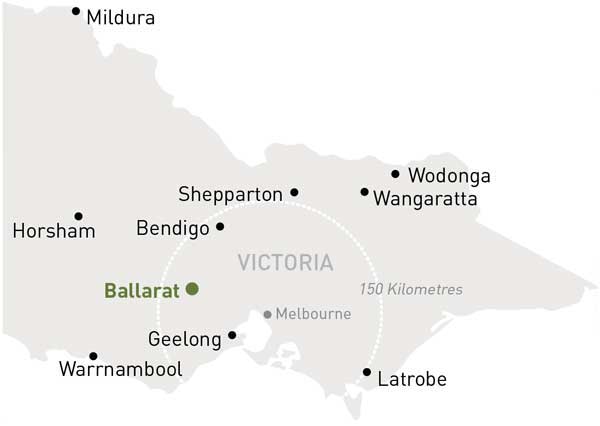Victoria’s third-most populous city, rich in culture and history and a centre for manufacturing, health, education and retail
| Local Government Area (LGA) | City of Ballarat |
| Neighbouring Local Government Areas | Golden Plains, Hepburn, Moorabool, Pyrenees |
| LGA Population, 2020 | 111,400 |
| Estimated Population, 2036 | 145,900 |
| Population Growth between 2015-2020 | 1.9% per annum |
| Forecast Population Growth | 1.7% per annum from 2016 to 2036 |
| Output | $6.4 billion Gross Regional Product |

Steeped in history, Ballarat is Victoria’s largest inland city, founded on the wealth of the famous Victorian gold rush, a legacy that continues today in Ballarat’s grand architecture and streetscapes.
Located 110km northwest of Melbourne, Ballarat is a major manufacturing, health, retail and education centre, and the principal service centre for the eastern part of the Grampians Central Highlands Region.
Ballarat represents both historic and contemporary regional Victoria. The city contains a mix of established residential and greenfield areas, with a number of historic streets and houses in the central part of the city.
Culture and lifestyle
Ballarat has a thriving arts, tourism and cultural scene. The city is strongly influenced by its gold rush history, which sets it apart from other regional cities. The Art Gallery of Ballarat, established in 1884, is Australia’s oldest and largest regional gallery, with a comprehensive collection of Australian art.
Ballarat has a diverse offering of entertainment including, local theatrical performances, music at local bars and pubs, larger international acts, and performances at iconic venues like Her Majesty’s Theatre. The city hosts various festivals throughout the year, including the Rockabilly Festival, Begonia Festival and Heritage Weekend. Ballarat also hosts a Chinese Mooncake Food Festival.
Employment, industry and infrastructure
Ballarat has about 9,156 businesses and a workforce of approximately 57,045 people.
Health Care and Social Assistance is the primary employment industry in Ballarat, followed by Construction, Retail Trade and Manufacturing. In the five year period 2015-2020, there was strong employment growth in Construction, Health Care and Social Assistance, Manufacturing, and Retail Trade.
In terms of Gross Value Added activity, Health Care and Social Assistance is the largest performing sector in Ballarat, generating $903 million in 2020. Construction, Manufacturing and Education and Training are also key industry sectors.
Ballarat is in a key strategic position with four main highways (the Western, Midland, Glenelg and Sunraysia) connecting it to the industrial centres of Melbourne, Adelaide, Geelong and Portland; the regional cities of Bendigo and Mildura; and agricultural areas in the Mallee and Wimmera. Melbourne International Airport and the ports of Melbourne and Geelong are located within a one-hour travel time of Ballarat.
| Major Businesses | Industry |
|---|---|
| MaxiTrans | Transport equipment manufacturing (trailing) |
| FMP Group | Transport equipment manufacturing (brake and friction materials) |
| McCain Foods | Fruit and vegetable processing (frozen food) |
| Mars | Sugar and confectionary manufacturing (snack foods) |
| IBM | Computer system design and related services |
| Haymes | Chemical manufacturing (paint products) |
| Ballarat Health Services | Health care and social assistance |
| Federation University Australia | Tertiary education |
| Alstom | Rail infrastructure |
